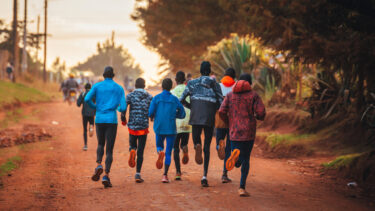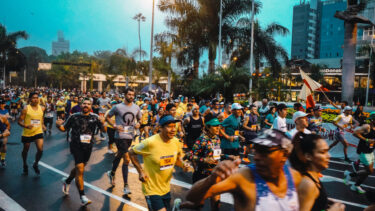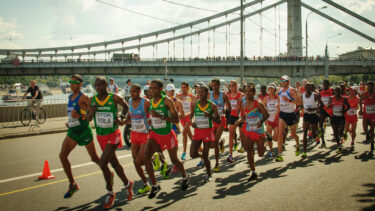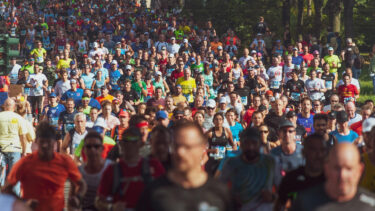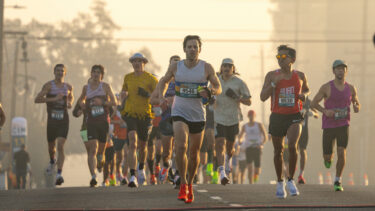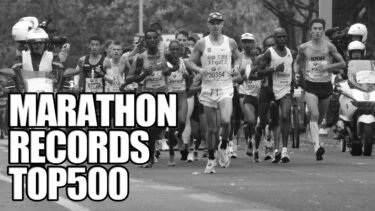Do you know how the sport of marathon running came to be what it is today? Its background is rich with tales from ancient Greece, numerous dramatic moments in the modern Olympics, and the relentless progress of science.

The Birth of the Marathon
The origin of the marathon traces back to the Battle of Marathon in 490 BC. After the Greek army’s victory over the Persian forces, a messenger named Philippides reportedly ran approximately 40km from Marathon to Athens, proclaimed “Rejoice, we are victorious!” and then collapsed and died. This historical anecdote is said to be the origin of the marathon’s name.
The Modern Olympics and the Standardization of Distance
The Marathon’s Debut and Early Confusion
The marathon was first held in the modern Olympics at the 1st Athens Olympics in 1896. The distance was about 40km at that time. However, initially, the distance varied from one competition to another, operating under the vague rule of “approximately 40km.”
The Drama of the 42.195km Birth
The current distance of 42.195km was set at the 4th London Olympics in 1908. Queen Alexandra of the United Kingdom requested that “the start line should be visible from the palace gardens, and the finish line in front of the royal box in the stadium.” This led to an additional 385 yards (approximately 352m) being added to the originally planned 42km, resulting in the iconic 42.195km.
This event at the London Games, along with the tragic story of Italian runner Dorando Pietri, became major factors in the official adoption of the current distance.
The Tragedy of Dorando Pietri
During the marathon at the 1908 London Olympics, Italian representative Dorando Pietri entered the stadium in the lead. However, suffering from extreme fatigue and dehydration, he became disoriented, took a wrong turn, and fell multiple times.
Amidst the roaring crowd, Pietri was repeatedly helped up by race officials and doctors, stumbling towards the finish line. Although he eventually crossed the finish line in first place with the help of officials, the assistance he received led to a protest from the American team, resulting in his disqualification. The gold medal was awarded to the second-place finisher, Johnny Hayes of the United States.
This incident is remembered as the “Tragedy of Dorando” and deeply moved many people. Queen Alexandra of the UK, recognizing his brave run, presented him with a special gold cup. This dramatic event is said to be one of the reasons the marathon distance was officially set at 42.195km.
Evolution of Olympic Marathon Distances (1st to 7th Games)
In 1921, the International Amateur Athletic Federation (now World Athletics) officially adopted 42.195km as the standard marathon distance. It has been used for the Olympics since the 8th Paris Games in 1924 and continues to this day.
Before that, the Olympic marathon distances were not strictly fixed and varied by competition:
- 1st Athens Olympics (1896): 40km
- 2nd Paris Olympics (1900): 40.26km
- 3rd St. Louis Olympics (1904): 40km
- 4th London Olympics (1908): 42.195km (the competition where the current distance was incidentally set)
- 5th Stockholm Olympics (1912): 40.2km
- 6th Berlin Olympics (1916): Canceled due to World War I
- 7th Antwerp Olympics (1920): 42.75km (considered the longest distance in Olympic marathon history)
Non-Olympic Marathon Races
Inspired by the success of the early Olympic marathons, marathon events began to be held worldwide. The Boston Marathon is particularly famous.
The first Boston Marathon was held in 1897, making it the oldest continuously held annual marathon in the world. Other early races included the “Tour de Paris Marathon” in 1902 and the “Yonkers Marathon” in 1907, but their distances were also inconsistent until the 1908 London Olympics.
Long-Distance Running Before the Modern Olympics
While long-distance running existed before the modern Olympics, it differed significantly from today’s competitive sport.
The Dolichos Race in Ancient Olympics
The Dolichos race was a long-distance event introduced in the ancient Olympics from 720 BC. It involved running back and forth multiple times on a straight stadium track. The distance varied but was typically around 3.8km for 10 laps. Unlike modern races that measure time, success largely depended on strategy and a strong final sprint.
However, despite the legendary run from Marathon to Athens, a formalized “marathon” competition did not exist in the ancient Olympics.
Long-Distance Running Cultures Worldwide
In various parts of the world, long-distance running was practiced in ways that differed from modern competitions with strict rules and timekeeping. These included competitive running and running as part of festivals or rituals.
- Ancient Mesoamerican Civilizations (Maya, Aztec, etc.): Long-distance messengers played a crucial role, sometimes covering hundreds of kilometers in a few days. Their abilities were highly valued and competed for. Records also indicate that sustained running was part of specific religious ceremonies and rituals.
- Indigenous Tribes of the Americas (Hopi, Zuni, etc.): Many Native American tribes, especially in the Southwest, were exceptional long-distance runners. Running was essential for hunting, messaging, travel, and religious ceremonies. Tribal competitions and extended runs for rain prayers were common. While not “races” in the modern sense, they involved elements of long-distance competition and a festival-like aspect where running itself was the objective.
- African Continent: In tribal societies, long-distance travel and messenger roles were important. Endurance running was often cultivated as part of warrior training and sometimes involved competitive elements.
- Edo Period Japan: “Hikyaku” (messengers) developed as a means of long-distance communication, covering considerable distances. In mountain asceticism (Shugendo), practices called “gyo” involved continuous running in the mountains for spiritual training and enlightenment, often covering ultra-long distances (e.g., Sen-nichi Kaihōgyō).
These examples show that from ancient times to the modern era, humans engaged in long-distance running for various purposes (practicality, faith, competition, training, etc.), competing or incorporating it into ceremonies and rituals.
The Remarkable Evolution of Marathon Records
Since the marathon distance was standardized to 42.195km in 1921, world records have been broken at an astonishing pace.
Progression of Men’s Marathon World Records
The first men’s marathon world record officially recognized by the International Amateur Athletic Federation was 2 hours, 29 minutes, 1.8 seconds, set by Albert Michelsen (USA) on October 12, 1925. This was the first time a human broke the 2-hour-30-minute barrier.
Let’s look at the record progression decade by decade:
- 1925-1935:
- Oct 12, 1925: Albert Michelsen (USA) 2:29:01.8
- Mar 21, 1935: Sohn Kee-chung (Japan/then) 2:26:14
- Reduction: approx. 2 minutes 47.8 seconds
- 1935-1945:
- No record broken during this period.
- Reduction: 0 seconds
- 1945-1955:
- June 14, 1952: Jim Peters (UK) 2:20:42.2
- Reduction: approx. 5 minutes 31.8 seconds
- 1955-1965:
- June 12, 1965: Morio Shigematsu (Japan) 2:12:00
- Reduction: approx. 8 minutes 42.2 seconds
- 1965-1975:
- May 30, 1969: Derek Clayton (Australia) 2:08:33.6
- Reduction: approx. 3 minutes 26.4 seconds
- 1975-1985:
- Apr 20, 1985: Carlos Lopes (Portugal) 2:07:12
- Reduction: approx. 1 minute 21.6 seconds
- 1985-1995:
- Apr 17, 1988: Belayneh Dinsamo (Ethiopia) 2:06:50
- Reduction: approx. 22 seconds
- 1995-2005:
- Sep 28, 2003: Paul Tergat (Kenya) 2:04:55
- Reduction: approx. 1 minute 55 seconds
- 2005-2015:
- Sep 28, 2014: Dennis Kimetto (Kenya) 2:02:57
- Reduction: approx. 1 minute 58 seconds
- 2015-2025 (Present):
- Oct 8, 2023: Kelvin Kiptum (Kenya) 2:00:35
- Reduction: approx. 2 minutes 22 seconds
From significant early reductions, the pace of record-breaking has accelerated in recent years, driven by advancements in shoe technology and the scientific approach to training.
The History and Leap of Women’s Marathon Running
The history of women participating in and completing full marathons is considerably more recent than men’s. For a long time, it was widely believed that long-distance running was physically impossible or inappropriate for women.
Women Who Broke Barriers
Two women, Roberta “Bobbi” Gibb and Kathrine Switzer, fundamentally changed this history.
- Roberta “Bobbi” Gibb (1966 Boston Marathon): She was the first woman to complete the Boston Marathon by “bandit” running (without official registration). Although unofficial, her finish in 3:21:40 was a groundbreaking demonstration that women could complete a full marathon.
- Kathrine Switzer (1967 Boston Marathon): She was the first woman to run the Boston Marathon with an official race bib (registered as “K.V. Switzer”). A famous incident occurred during the race when an official tried to physically remove her, but she completed it. This event became a symbol of the movement for women’s right to participate in marathons and played a crucial role in the history of women’s sports participation.
The efforts and courage of these women significantly contributed to the development of women’s marathon running. In 1972, the Boston Marathon officially allowed female runners, and in 1984, the women’s marathon became an official Olympic event at the Los Angeles Games.
Progression of Women’s Marathon World Records
Official records for women’s full marathons began in the late 1960s and early 1970s.
Baseline: February 28, 1970: Caroline Walker (USA) 3 hours, 2 minutes, 53 seconds
- 1970-1980:
- This decade saw a rapid expansion of women’s participation and significant record reductions.
- Oct 21, 1979: Grete Waitz (Norway) 2:27:33
- Reduction: approx. 35 minutes 20 seconds
- 1980-1990:
- Apr 21, 1985: Ingrid Kristiansen (Norway) 2:21:06
- Reduction: approx. 4 minutes 36 seconds
- 1990-2000:
- Sep 26, 1999: Tegla Loroupe (Kenya) 2:20:43
- Reduction: approx. 23 seconds
- 2000-2010:
- Apr 13, 2003: Paula Radcliffe (UK) 2:15:25
- Reduction: approx. 5 minutes 18 seconds (Paula Radcliffe made a substantial reduction)
- 2010-2020:
- Oct 13, 2019: Brigid Kosgei (Kenya) 2:14:04
- Reduction: approx. 1 minute 21 seconds
- 2020-2025 (Present):
- Sep 24, 2023: Tigist Assefa (Ethiopia) 2:11:53
- Oct 13, 2024: Ruth Chepngetich (Kenya) 2:09:56 ( Record pending approval)
- Reduction: approx. 4 minutes 08 seconds
The evolution of women’s marathon records reflects not only improvements in athletic performance but also changes in societal perceptions of women’s sports participation and the accompanying development of supportive environments.
Factors in Marathon Record Evolution
The astonishing improvement in marathon times is not solely due to increased athlete ability but is a complex interplay of various factors.
1. Evolution of Training Methods and Scientific Approaches
Early marathon training was largely based on empirical knowledge. Today, training incorporates diverse scientific insights from physiology, nutrition, psychology, and more. Various methods, such as altitude training, interval training, and Long Slow Distance (LSD), are established and optimized for individual athletes.
2. Understanding the Importance of Nutrition and Hydration
There was a time when even adequate hydration during races was not common. Now, strategies like proper fluid and electrolyte replenishment during races and carbohydrate loading are well-established, significantly contributing to athletes’ performance maintenance and recovery.
3. Advancements in Equipment
- Shoes: The evolution of running shoes, prioritizing cushioning, energy return, and lightness, has greatly contributed to faster times. In recent years, shoes with carbon plates have been a major factor in breaking records.
- Apparel: High-performance fabrics that offer excellent breathability and lightness also enhance athlete comfort and support performance.
4. Faster Courses and the Introduction of Pacemakers
Major marathon events where world records are set tend to feature courses with minimal elevation changes and less wind interference. In elite races, the presence of pacemakers who run at a predetermined speed is essential. This allows athletes to maintain a consistent high pace without unnecessary fluctuations, increasing the likelihood of record-breaking performances.
5. Growth in Athlete Pool and Increased Competition
As the marathon gained global popularity and the number of participants grew, more talented athletes emerged. Intensified competition at the top level pushes athletes to elevate each other, motivating them to achieve faster times.
6. Standardization of Distance
The unification of the marathon distance to 42.195km in 1921 made it possible to compare records across different competitions and eras, clearly defining the significance of breaking records.
These factors, acting in combination, have brought the men’s marathon world record from Albert Michelsen’s 2:29:01.8 in 1925 to the 2-hour range today. The first sub-2-hour marathon for men is expected to be achieved in the not-too-distant future.
The marathon, which began with the story of a single messenger, has chronicled a history of human challenge and evolution. Scientific training, innovative footwear, and the passion of runners worldwide continue to converge, pushing records ever lower.
The ultimate goal of the first “sub-2-hour” marathon is no longer just a dream. This pursuit will offer hope to countless runners, demonstrating our potential to transcend our own limits.


